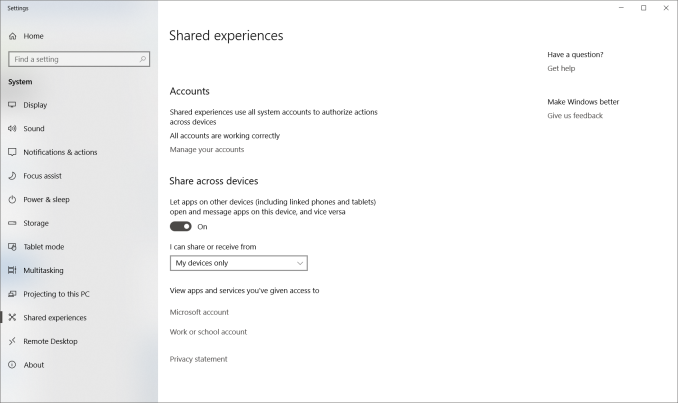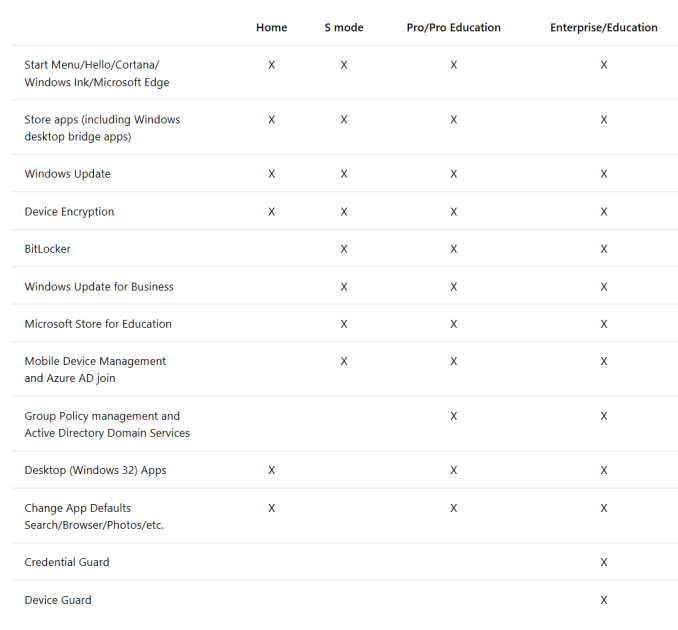The Windows 10 April Update (1803): The Littlest Big Update
by Brett Howse on May 25, 2018 8:00 AM EST- Posted in
- Software
- Operating Systems
- Windows
- Microsoft
- Windows 10
Nearby Share
One feature that should be very useful to certain people is Nearby Share. This lets you quickly and easily share files between people from PC to PC, without having to send an email or use a messaging app as the transfer tool. Nearby Share works over Bluetooth or Wi-Fi, and will use Wi-Fi as the preference. In an office, this was something done via a USB drive most recently, but with wireless and Bluetooth in all modern laptops, it makes sense to leverage that to avoid a step.
It should be very useful in certain situations, and isn’t tied to an account so you can send to any nearby device. The receiver will have the option of accepting the file. It’s not on by default, but can be toggled on when needed. It’s definitely something you’d not want to leave on.
Easy Bluetooth
Windows 10 now supports a simpler Bluetooth pairing process for some devices which lets you pair devices with a single click. You’ll get a pop-up notification asking if you want to pair a device, and if you say yes, it’s all setup. Devices have to support this though, and ones that require PINs are not going to work with a single click setup.
Windows 10 S Mode
Windows 10 S launched with the Surface Laptop as its first device to offer the constrained version of Windows 10 that restricts users to only running apps from the Store. The idea was to keep people from harming themselves, and to keep performance levels where they should be, by not allowing people to just install whatever they want, and to keep apps in packages that allow for easy removal and less items running at startup. This is pretty much how any modern smartphone works of course, but the downside to it on Windows 10 was that the Microsoft Store is not known as one of the key selling features, so uptake and usuage of Windows 10 S had to be pretty small. With the April Update, this is replaced by Windows 10 in S Mode, which is just a setting that can be enabled on any PC to make it like Window 10 S was. It'll still likely never get used, but it's a much better solution than another version of the OS just for this purpose. There's reasons you'd want this of course - education being a great example - but the average consumer is choosing Windows for the legacy application support, so this new model is definitely the better way to handle it.
The drawback is that S Mode is a one-way setting at the moment. A machine can be set in S mode when imaged using an unattended.xml file and dism, but if it's set back to regular Windows 10, there's not a way to switch back and forth.












161 Comments
View All Comments
Lolimaster - Wednesday, May 30, 2018 - link
Why have win10 installed in the 1st place, Win8.1 update 3 is rock solid with none of the bloatware and update when you want if you want to do it.SirPerro - Monday, May 28, 2018 - link
From a consumer standpoint, it's peanuts and an isolated case.But this is the kind of issues that make the enterprise admins say "fuck it, I'm not updating this shit"
kuttan - Sunday, May 27, 2018 - link
Not just him I am another casualty of April 2018 update and was forced to revert to v1709. Only gamers who don't face much issues with April 2018 update because they don't use or have any idea outside gaming application or usage.lmcd - Monday, May 28, 2018 - link
I mean the system he described there is pretty normal except for the RAID config. If that's hardware RAID the system shouldn't even know, right? I assume it's hybrid RAID which would explain the problems, but still: I wouldn't expect a system composed of standard parts released in the last 2-3 years to run into issues.jordanclock - Friday, May 25, 2018 - link
What kind of SSDs are you using?BurntMyBacon - Tuesday, May 29, 2018 - link
There are known issues with some Intel and Toshiba SSDs, but in this case, the RAID-0 may be the culprit. It is an extra driver that has to be accounted for and RAID-0 for boot drives have historically had weaker support (require extra steps and don't always work) than single drive setups across many versions of Windows. I also have an i7-6700K, 64GB RAM, and NVMe (Samsung 950PRO) boot drive setup. Update worked out fine for me, but I don't have RAID-0.Ophion - Friday, May 25, 2018 - link
Similar problems happened to two people I know, severe performance drops that made the system unresponsive. I personally had troubles even getting the update to install. Got stuck on a black screen with zero drive activity every time and had to roll back, until I unplugged every peripheral and it finally went through.And after doing so, the update apparently had reset all of my microphone settings and invalidated my display driver.
HStewart - Friday, May 25, 2018 - link
It is probably like my Xeon system, you have some drive - like my Realtek driver failing because it old.ಬುಲ್ವಿಂಕಲ್ ಜೆ ಮೂಸ್ - Sunday, May 27, 2018 - link
Cmon Stewie, your Realtek driver did not fail because it's oldIn fact, your driver still works fine
It failed because you installed Windows 10
bananaforscale - Sunday, May 27, 2018 - link
Drivers aren't hardware, they don't fail because they are "old". Your understanding of computers could use brushing up. If something that has worked previously on an OS fails after an update it's not an age issue, it's a bug (or as some might say "a regression").